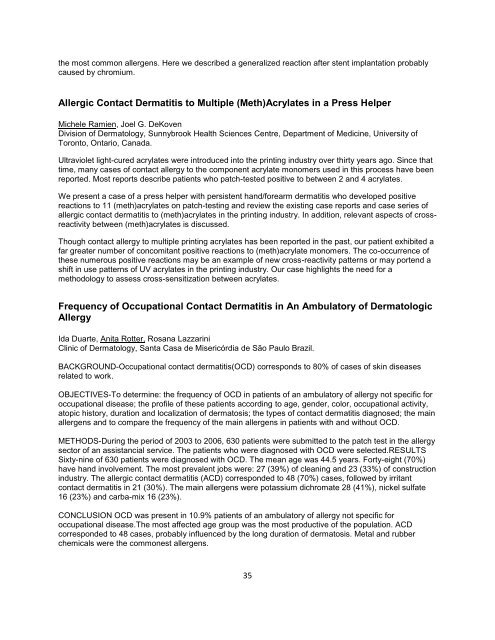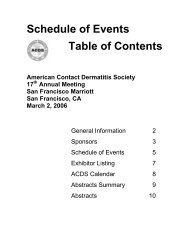American Contact Dermatitis Society 21 Annual Meeting
American Contact Dermatitis Society 21 Annual Meeting
American Contact Dermatitis Society 21 Annual Meeting
You also want an ePaper? Increase the reach of your titles
YUMPU automatically turns print PDFs into web optimized ePapers that Google loves.
the most common allergens. Here we described a generalized reaction after stent implantation probably<br />
caused by chromium.<br />
Allergic <strong>Contact</strong> <strong>Dermatitis</strong> to Multiple (Meth)Acrylates in a Press Helper<br />
Michele Ramien, Joel G. DeKoven<br />
Division of Dermatology, Sunnybrook Health Sciences Centre, Department of Medicine, University of<br />
Toronto, Ontario, Canada.<br />
Ultraviolet light-cured acrylates were introduced into the printing industry over thirty years ago. Since that<br />
time, many cases of contact allergy to the component acrylate monomers used in this process have been<br />
reported. Most reports describe patients who patch-tested positive to between 2 and 4 acrylates.<br />
We present a case of a press helper with persistent hand/forearm dermatitis who developed positive<br />
reactions to 11 (meth)acrylates on patch-testing and review the existing case reports and case series of<br />
allergic contact dermatitis to (meth)acrylates in the printing industry. In addition, relevant aspects of crossreactivity<br />
between (meth)acrylates is discussed.<br />
Though contact allergy to multiple printing acrylates has been reported in the past, our patient exhibited a<br />
far greater number of concomitant positive reactions to (meth)acrylate monomers. The co-occurrence of<br />
these numerous positive reactions may be an example of new cross-reactivity patterns or may portend a<br />
shift in use patterns of UV acrylates in the printing industry. Our case highlights the need for a<br />
methodology to assess cross-sensitization between acrylates.<br />
Frequency of Occupational <strong>Contact</strong> <strong>Dermatitis</strong> in An Ambulatory of Dermatologic<br />
Allergy<br />
Ida Duarte, Anita Rotter, Rosana Lazzarini<br />
Clinic of Dermatology, Santa Casa de Misericórdia de São Paulo Brazil.<br />
BACKGROUND-Occupational contact dermatitis(OCD) corresponds to 80% of cases of skin diseases<br />
related to work.<br />
OBJECTIVES-To determine: the frequency of OCD in patients of an ambulatory of allergy not specific for<br />
occupational disease; the profile of these patients according to age, gender, color, occupational activity,<br />
atopic history, duration and localization of dermatosis; the types of contact dermatitis diagnosed; the main<br />
allergens and to compare the frequency of the main allergens in patients with and without OCD.<br />
METHODS-During the period of 2003 to 2006, 630 patients were submitted to the patch test in the allergy<br />
sector of an assistancial service. The patients who were diagnosed with OCD were selected.RESULTS<br />
Sixty-nine of 630 patients were diagnosed with OCD. The mean age was 44.5 years. Forty-eight (70%)<br />
have hand involvement. The most prevalent jobs were: 27 (39%) of cleaning and 23 (33%) of construction<br />
industry. The allergic contact dermatitis (ACD) corresponded to 48 (70%) cases, followed by irritant<br />
contact dermatitis in <strong>21</strong> (30%). The main allergens were potassium dichromate 28 (41%), nickel sulfate<br />
16 (23%) and carba-mix 16 (23%).<br />
CONCLUSION OCD was present in 10.9% patients of an ambulatory of allergy not specific for<br />
occupational disease.The most affected age group was the most productive of the population. ACD<br />
corresponded to 48 cases, probably influenced by the long duration of dermatosis. Metal and rubber<br />
chemicals were the commonest allergens.<br />
35






